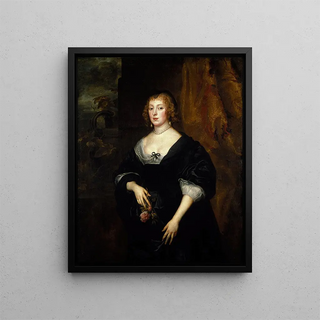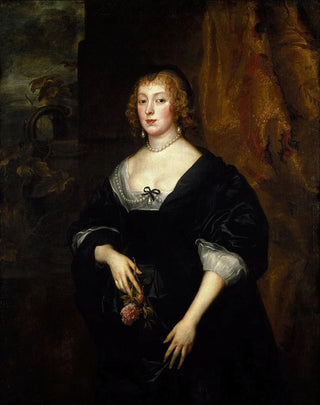Art print | Dame Dacre - Antoine van Dyck


View from behind

Frame (optional)
In the world of art, some works transcend their era to become timeless witnesses to beauty and humanity. "Dame Dacre" by Antoine van Dyck is a shining example. This portrait, which captures the very essence of 17th-century nobility, transports us into a universe where refinement and delicacy blend with technical virtuosity. The depiction of this lady, with her penetrating gaze and majestic attitude, invites the viewer to reflect on her life and status, while revealing van Dyck's unparalleled mastery in the art of portraiture. Through this artwork, the artist manages to establish a dialogue between the past and the present, making each contemplation unique and personal.
Style and uniqueness of the work
van Dyck's style is characterized by subtle elegance and meticulous attention to detail. In "Dame Dacre," the composition is carefully orchestrated, highlighting not only the central figure but also the surrounding elements that enhance the atmosphere of grandeur. The sumptuous drapery, the play of light and shadow, as well as the rich and harmonious color palette, create a visual depth that captivates the eye. Every brushstroke seems charged with emotion, and the way van Dyck manages to capture the expression and personality of his model is simply remarkable. This artwork is not limited to a mere representation; it tells a story, that of a woman of power and dignity, while offering a fascinating glimpse into the social conventions of her time.
The artist and his influence
Antoine van Dyck, a pupil of Rubens, established himself as one of the greatest portraitists of his era. His influence is undeniable, not only in the field of portraiture but also in the way he redefined baroque painting. By focusing on the psychology of characters, he paved the way for a new artistic approach that favors individuality and personal expression. van Dyck traveled across Europe, leaving an indelible mark on artists such as Gainsborough and Sargent. His unique style, combining

Matte finish

View from behind

Frame (optional)
In the world of art, some works transcend their era to become timeless witnesses to beauty and humanity. "Dame Dacre" by Antoine van Dyck is a shining example. This portrait, which captures the very essence of 17th-century nobility, transports us into a universe where refinement and delicacy blend with technical virtuosity. The depiction of this lady, with her penetrating gaze and majestic attitude, invites the viewer to reflect on her life and status, while revealing van Dyck's unparalleled mastery in the art of portraiture. Through this artwork, the artist manages to establish a dialogue between the past and the present, making each contemplation unique and personal.
Style and uniqueness of the work
van Dyck's style is characterized by subtle elegance and meticulous attention to detail. In "Dame Dacre," the composition is carefully orchestrated, highlighting not only the central figure but also the surrounding elements that enhance the atmosphere of grandeur. The sumptuous drapery, the play of light and shadow, as well as the rich and harmonious color palette, create a visual depth that captivates the eye. Every brushstroke seems charged with emotion, and the way van Dyck manages to capture the expression and personality of his model is simply remarkable. This artwork is not limited to a mere representation; it tells a story, that of a woman of power and dignity, while offering a fascinating glimpse into the social conventions of her time.
The artist and his influence
Antoine van Dyck, a pupil of Rubens, established himself as one of the greatest portraitists of his era. His influence is undeniable, not only in the field of portraiture but also in the way he redefined baroque painting. By focusing on the psychology of characters, he paved the way for a new artistic approach that favors individuality and personal expression. van Dyck traveled across Europe, leaving an indelible mark on artists such as Gainsborough and Sargent. His unique style, combining






